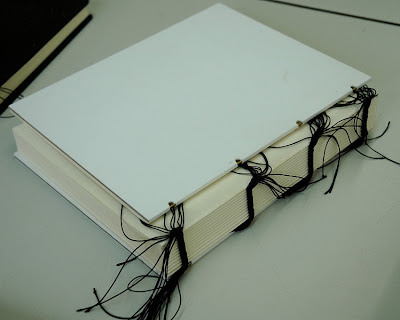Aloha, Oregon
Daniel Kelm's workshop on June 18-20, 2010 at Oregon College of Art and Craft was great. His style of teaching the "Double-Raised Cords Meets the Gutter Wire" really made us all think. He would show us things and talk about what we had to accomplish, but he also had us do a lot of problem solving. This was not a standard class with a kit and directions. We had a kit, yes, but the directions we made up as we went with his guidance. For me I found it ideal, as it gave me a lot of ideas for problems that I face everyday in book repairs, not just creating new structures.

Cover ready to place on text block
Daniel said that originally this binding was designed for a book that was a very large format with thick paper that was not strong enough to use regular sewing techniques. Myself, I feel it would make a lovely structure for photo albums. The pages open nicely and the feel is good.
We used fine stainless steel wires and silk suture thread to sew the text block. The stainless steel wires would really be considered rods, as they are very stiff but fine. In the cover was a brass rod that attached the cover to the text block. The cover was covered in Ultra Suede. We were supposed to paint it with acrylic paint but ran out of time to get the first layer dry before decorating it with fine splatters or what ever we chose to do. He talked about it so we could do it if we wanted to at home, but I choose to leave mine plain, as I love the look and feel of the Ultra Suede.
Every morning we had show and tell about our own books and his. He brought in some awesome structures using hinges and wire rods. One he called a moebius strip--and it was. (editor’s note: there is an on-line video of Daniel Kelm demonstrating this book, Neo Emblemata Nova.) Made of square boards except for four sets of triangles, it all was hinged together in such a way that when you opened it, it made a nice clacking sound. You could lay it on the table in a circle of sorts; he had prints of etchings of different chemistry things from a very old publication. In addition, he had other book structures to share that were just as interesting.
I think that one of the most important things I got out of this class and several others I have taken of late is that just about anything that will work goes. In other words, don't be afraid to try your idea just because it isn't traditional. Just use archival materials and then go for it.
Daniel Kelm at the chalkboard

No comments:
Post a Comment